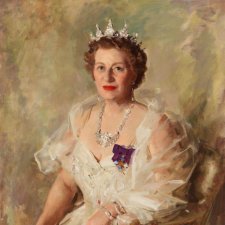- About us
- Support the Gallery
- Venue hire
- Publications
- Research library
- Organisation chart
- Employment
- Contact us
- Make a booking
- Onsite programs
- Online programs
- School visit information
- Learning resources
- Little Darlings
- Professional learning
Dr Lowitja O’Donoghue AC CBE DSG (1932–2024), a Yankunytjatjara woman, dedicated her life’s work to advancing the rights and wellbeing of Australia’s First Nations peoples. Born at Indulkana in the Anangu Pitjantjatjara Yankunytjatjara Lands in South Australia, O’Donoghue was removed from her mother at the age of two and raised in a children’s home. The first Aboriginal woman to complete nursing training at the Royal Adelaide Hospital, she travelled to remote communities, learning about her heritage through ‘just doing what I could to heal people’. Among her many achievements, she was Chair of the National Aboriginal Conference, Chair of the Aboriginal Development Commission and Chair of the Aboriginal and Torres Strait Islander Commission, where she helped to draft the Mabo legislation. The Lowitja Institute for Aboriginal and Torres Strait Islander health research was established in 2010, and in 2022 formed the Lowitja O’Donoghue Foundation to continue and preserve its patron’s legacy. For her 2006 portrait by Robert Hannaford, O’Donoghue chose a red suit that she regularly wore for official occasions, along with jewellery proudly signifying her cultural heritage. Hannaford painted the portrait during several sessions at his studio in Adelaide, and says he aimed to capture his sitter’s ‘vast understanding and sympathy’.
Commissioned with funds donated by BHP Billiton Limited, Rio Tinto Aboriginal Fund, Newmont Australia Limited, Reconciliation Australia, Hon Paul Keating and Hon Fred Chaney 2006
© Commonwealth of Australia
This portrait is of Lowitja O'Donoghue, Yankunjatjara woman and Indigenous rights campaigner. It was painted by Robert Hannaford in 2006 in oil on canvas. The work measures about 1.4 m tall by 1.4 m wide, set in its wide frame of dark wood. The portrait is painted realistically with loosely applied brushstrokes. Lowitja wears a bright red skirt-suit and is seated in front of a dark background.
The scene is lit from the top left. Lowitja is illuminated in a soft pool of light filling the top right and centre of the painting. Pale green-grey and blue-grey brush strokes at the top right curve around and down towards the bottom left, their direction changing, sweeping around and getting darker towards the lower edge of the canvas.
Lowitja sits on a dark wood chair in the centre of the image. The rounded corners of its back rise above each of her shoulders. Her head is tilted slightly down to her left with her chin angled up. Lowitja’s silvery hair is short, parted on the side, and styled in a wave over her forehead. Her skin is in warm honey tones and her cheeks are tinged pink. Lowitja has fine steeply-arched eyebrows above her dark eyes that gaze directly at us. Her nose is broad and deep grooves flow from it to the outer edges of her thin rosy lips. Her lips are closed and slightly downturned, creating soft jowels which frame her broad chin.
In the portrait Lowitja wears a loosley-fitted long jacket that runs down her lap to her knees. It has an Aboriginal Flag pin on the left lapel and is open, with three large round gold buttons gleaming brightly down its left side. A strand of black red and yellow beads and an oval shaped Aboriginal Flag pendant on a fine chain stand out against her black round-necked top.
Lowitja’s elbows rest lightly on the carved wooden arms of the chair and her hands lie with fingers extended in her lap. On the ring finger of her left hand she wears a wide yellow-gold band, while on her right a ring is set with a large black rectangular stone.
Lowitja’s red skirt extends over her knees and out of frame. The same red has been used by the artist to sign ‘Hannaford 06’ on the bottom right of the canvas.
Audio description written by Lucinda Shawcross and voiced by Amy Middleby
Robert Hannaford AM (age 62 in 2006)
Dr Lowitja O'Donoghue AC CBE DSG (age 74 in 2006)
Hon. Fred Chaney (1 portrait supported)
Hon. Paul Keating (1 portrait supported)
Newmont Australia Ltd (1 portrait supported)
Reconciliation Australia (1 portrait supported)
Rio Tinto Aboriginal Fund (1 portrait supported)
BHP Billiton (1 portrait supported)



On one level The Companion talks about the most famous and frontline Australians, but on another it tells us about ourselves.



Robert Hannaford has completed around 400 portraits over the span of his career.



Angus Trumble treats the gallery’s collection with a dab hand.